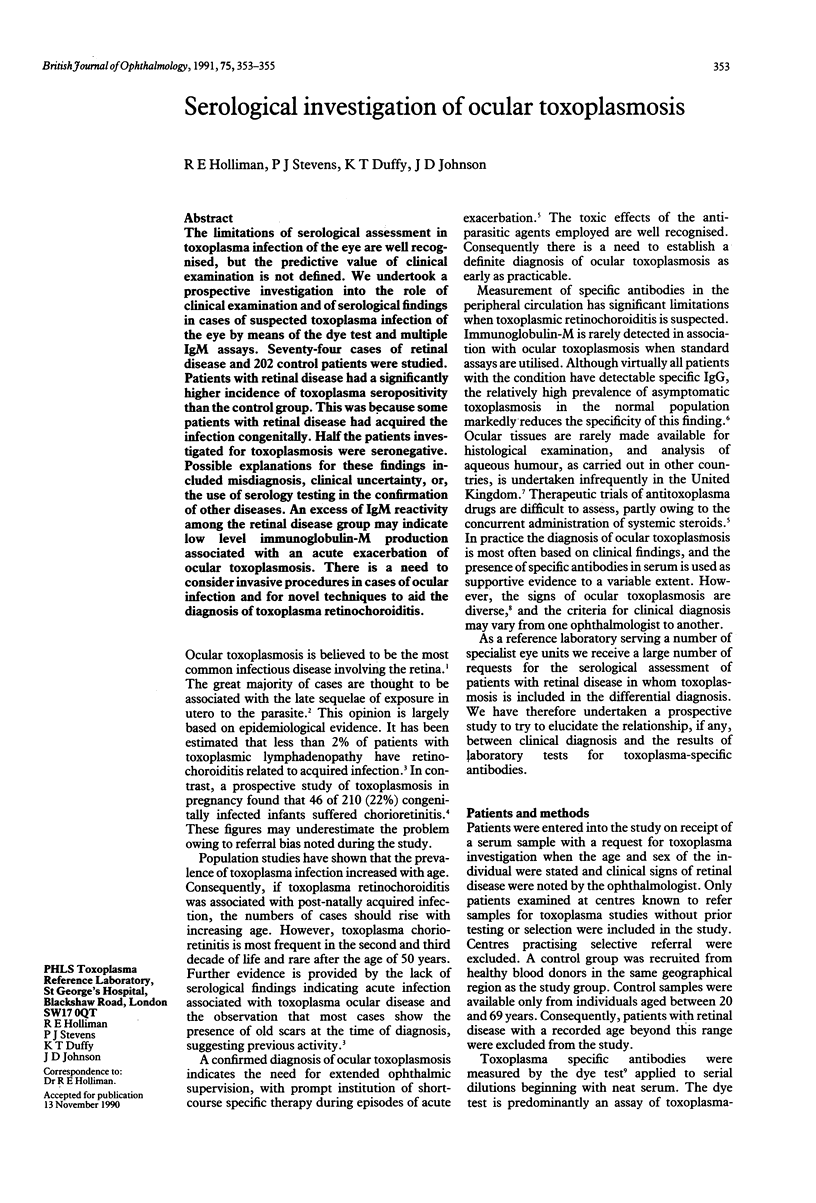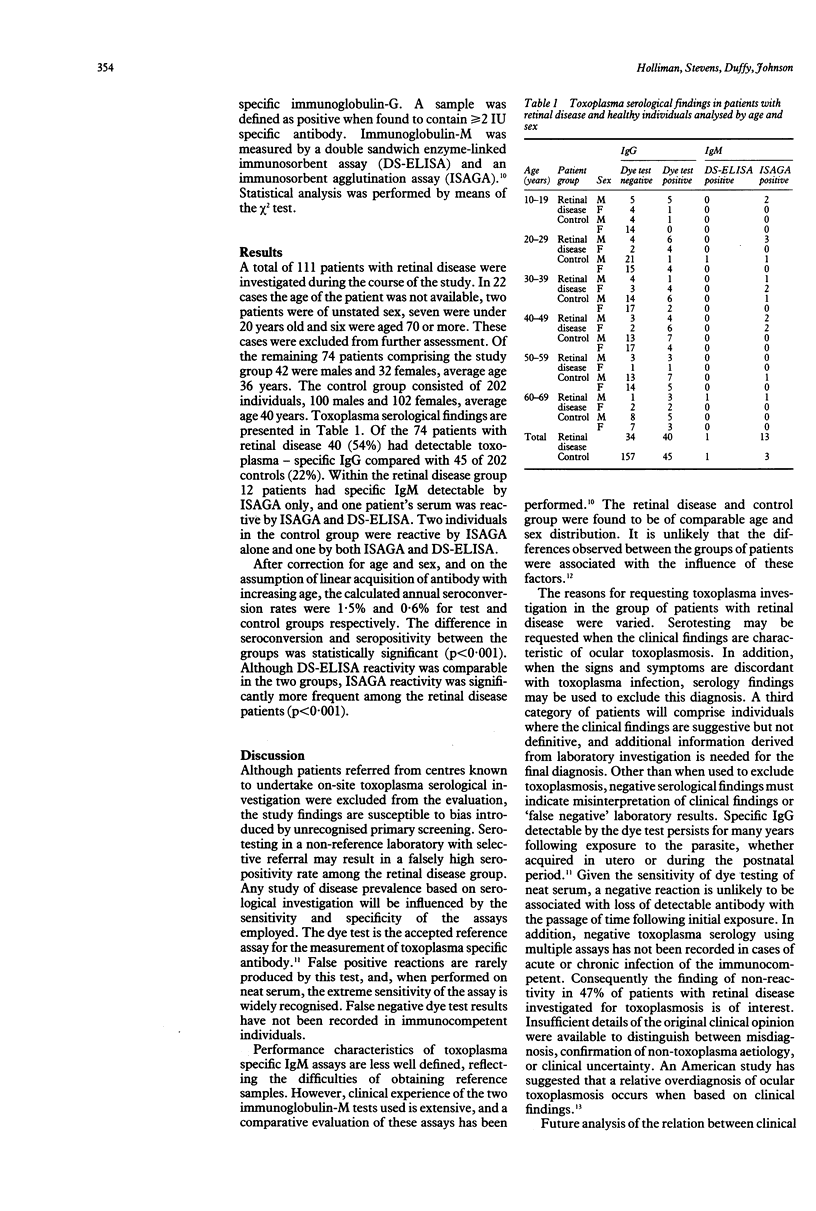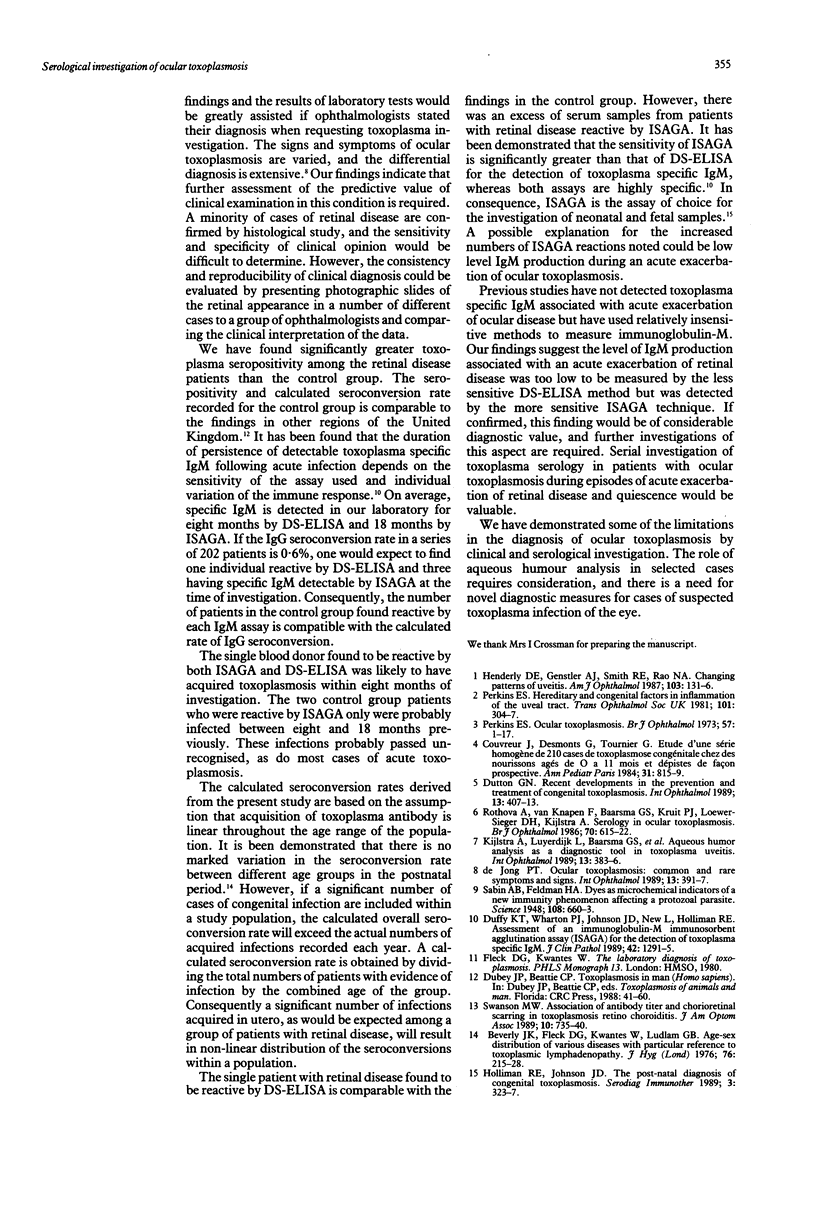Abstract
The limitations of serological assessment in toxoplasma infection of the eye are well recognised, but the predictive value of clinical examination is not defined. We undertook a prospective investigation into the role of clinical examination and of serological findings in cases of suspected toxoplasma infection of the eye by means of the dye test and multiple IgM assays. Seventy-four cases of retinal disease and 202 control patients were studied. Patients with retinal disease had a significantly higher incidence of toxoplasma seropositivity than the control group. This was because some patients with retinal disease had acquired the infection congenitally. Half the patients investigated for toxoplasmosis were seronegative. Possible explanations for these findings included misdiagnosis, clinical uncertainty, or, the use of serology testing in the confirmation of other diseases. An excess of IgM reactivity among the retinal disease group may indicate low level immunoglobulin-M production associated with an acute exacerbation of ocular toxoplasmosis. There is a need to consider invasive procedures in cases of ocular infection and for novel techniques to aid the diagnosis of toxoplasma retinochoroiditis.
Full text
PDF


Selected References
These references are in PubMed. This may not be the complete list of references from this article.
- Beverley J. K., Fleck D. G., Kwantes W., Ludlam G. B. Age-sex distribution of various diseases with particular reference to toxoplasmic lymphadenopathy. J Hyg (Lond) 1976 Apr;76(2):215–228. doi: 10.1017/s002217240005511x. [DOI] [PMC free article] [PubMed] [Google Scholar]
- Couvreur J., Desmonts G., Tournier G., Szusterkac M. Etude d'une série homogène de 210 cas de toxoplasmose congénitale chez des nourrissons âgés de 0 à 11 mois et dépistés de facon prospective. Ann Pediatr (Paris) 1984 Nov;31(10):815–819. [PubMed] [Google Scholar]
- Duffy K. T., Wharton P. J., Johnson J. D., New L., Holliman R. E. Assessment of immunoglobulin-M immunosorbent agglutination assay (ISAGA) for detecting toxoplasma specific IgM. J Clin Pathol. 1989 Dec;42(12):1291–1295. doi: 10.1136/jcp.42.12.1291. [DOI] [PMC free article] [PubMed] [Google Scholar]
- Dutton G. N. Recent developments in the prevention and treatment of congenital toxoplasmosis. Int Ophthalmol. 1989 Dec;13(6):407–413. doi: 10.1007/BF02306490. [DOI] [PubMed] [Google Scholar]
- Henderly D. E., Genstler A. J., Smith R. E., Rao N. A. Changing patterns of uveitis. Am J Ophthalmol. 1987 Feb 15;103(2):131–136. doi: 10.1016/s0002-9394(14)74217-5. [DOI] [PubMed] [Google Scholar]
- Kijlstra A., Luyendijk L., Baarsma G. S., Rothova A., Schweitzer C. M., Timmerman Z., de Vries J., Breebaart A. C. Aqueous humor analysis as a diagnostic tool in toxoplasma uveitis. Int Ophthalmol. 1989 Dec;13(6):383–386. doi: 10.1007/BF02306485. [DOI] [PubMed] [Google Scholar]
- Perkins E. S. Hereditary and congenital factors in inflammations of the uveal tract. Trans Ophthalmol Soc U K. 1981 Sep;101(3):304–307. [PubMed] [Google Scholar]
- Perkins E. S. Ocular toxoplasmosis. Br J Ophthalmol. 1973 Jan;57(1):1–17. doi: 10.1136/bjo.57.1.1. [DOI] [PMC free article] [PubMed] [Google Scholar]
- Rothova A., van Knapen F., Baarsma G. S., Kruit P. J., Loewer-Sieger D. H., Kijlstra A. Serology in ocular toxoplasmosis. Br J Ophthalmol. 1986 Aug;70(8):615–622. doi: 10.1136/bjo.70.8.615. [DOI] [PMC free article] [PubMed] [Google Scholar]
- Sabin A. B., Feldman H. A. Dyes as Microchemical Indicators of a New Immunity Phenomenon Affecting a Protozoon Parasite (Toxoplasma). Science. 1948 Dec 10;108(2815):660–663. doi: 10.1126/science.108.2815.660. [DOI] [PubMed] [Google Scholar]
- Swanson M. W. Association of antibody titer and chorioretinal scarring in toxoplasmosis retinochoroiditis. J Am Optom Assoc. 1989 Oct;60(10):735–740. [PubMed] [Google Scholar]
- de Jong P. T. Ocular toxoplasmosis; common and rare symptoms and signs. Int Ophthalmol. 1989 Dec;13(6):391–397. doi: 10.1007/BF02306487. [DOI] [PubMed] [Google Scholar]


